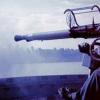MORE HANDBOOKS ARE ON THEIR WAY! We will let you know when they get here.
×
-
Posts
1,056 -
Joined
-
Last visited
Reputation Activity
-
 grsjax got a reaction from reklein in Can i live without a BYRNES TABLE SAW
grsjax got a reaction from reklein in Can i live without a BYRNES TABLE SAW
A table saw falls into the nice to have column unless you are planning on doing a lot of straight cuts. If you want to get one but don't want or need a top of the line Byrnes you can usually find Dremel table saws on eBay for under $100, sometimes a lot less. They are pretty good out of the box but can be vastly improved by tuning and a few mods. The cheap table saws from Harbor Freight and others are ok but not up to doing really fine work.
-
 grsjax reacted to jud in Swivel gun mounts
grsjax reacted to jud in Swivel gun mounts
There would need to be an iron socket in the top of any wood post to receive the swivel pin from the gun. The fit needs to have some give in it which would allow for a hammer blow to develop, without a socket liner the socket itself would be enlarged. The cap was probably forged with the socket as an integral part and the top of the post fitted to it.
jud
-
 grsjax got a reaction from mtaylor in Swivel gun mounts
grsjax got a reaction from mtaylor in Swivel gun mounts
Try using copper foil. Blacken it and glue to the head of the post.
-
 grsjax got a reaction from DocBlake in Swivel gun mounts
grsjax got a reaction from DocBlake in Swivel gun mounts
Since no one else has answered I will take a shot at it. Swivel guns were mounted on stout posts bolted to the frame of the ship. I believe they were at least 6x6 inchs and has a metal cap on the top to mount the gun. The cap was there to prevent the post from splitting from the stress of the recoil.
-
 grsjax got a reaction from DocBlake in Swivel gun mounts
grsjax got a reaction from DocBlake in Swivel gun mounts
Try using copper foil. Blacken it and glue to the head of the post.
-
 grsjax got a reaction from mtaylor in Swivel gun mounts
grsjax got a reaction from mtaylor in Swivel gun mounts
Since no one else has answered I will take a shot at it. Swivel guns were mounted on stout posts bolted to the frame of the ship. I believe they were at least 6x6 inchs and has a metal cap on the top to mount the gun. The cap was there to prevent the post from splitting from the stress of the recoil.
-
 grsjax reacted to Jaager in How to best apply stains
grsjax reacted to Jaager in How to best apply stains
A stain is essentially a paint. If you apply it before glue assembly - there is a chance that the glue joint will fail because the stain will keep the glue from penetrating the wood. Give some thought to using an aqueous or alcohol based wood dye. It penetrates the wood instead of being a surface coat. If it is water based, you first wet the wood with water or water with some PVA glue mixed in. This will raise the grain - the wood is sanded when dry and then dyed. It will not need to be sanded again so no removal of dye. The wood will glue as well as it will in a raw state. A clear satin or matt finish applied after assembly. A dye will leave the wood looking as though it was the original wood - instead of the "muddy" effect of a stain.
-
 grsjax reacted to Talos in Battle cruiser, Armed Cruiser or Battleship. how or why they are designate
grsjax reacted to Talos in Battle cruiser, Armed Cruiser or Battleship. how or why they are designate
In the 1937 edition of Jane’s Fighting Ships, the Deutschlands are listed as “armored ship”, with the German “panzerschiffe” in parentheses. That term was used by the Germans to get around the Washington Naval Treaty that said they couldn’t have any battleships. It was an older term they used in WWI as the rough equivalent of the armored cruiser, while linienschiffe (ships of the line) were the battleships. So technically they were counted as “heavy cruisers” under the WNT. The armament of 11” guns was about the maximum they could get away with without being openly building battleships and was their standard battlecruiser armament in WWI. All the other navies were moving to 14-15” guns on battleships (minus Nelson and Rodney with their 16” guns and a smattering of other calibers). The other propsed armaments were 4 x 15” guns and 6 x 12” guns before they settled on 6 x 11”.
Heavy and Light Cruisers replaced all the old terms under the WNT, with the former armed with roughly 8” guns and the latter 6”. With the older types, the major difference (besides size) between armored cruisers and protected cruisers was armored cruisers had a battleship-style armored belt at the waterline (though thinner, of course), while protected cruisers were armored with an angled, armored deck and subdivision, coal bunkers, gunshields, etc. Armored cruisers in the Royal Navy were armed with 9.2” guns in the manner of pre-dreadnaughts. The first battlecruisers were intended by Fisher to be an evolution of armored cruisers, armed with multiple 9.2” turrets, but they were given 12” battleship guns instead, which was the cause of their difficulties later on because they were misused in the battle line instead of their intended job. Basically they were big and expensive and the RN couldn’t afford not to put every ship armed with battleship-grade guns in the main fleet, no matter their lack of armor.
They were actually more survivable than most people give them credit for. The extreme length of the ships tended to absorb damage. The biggest vulnerability in the British ships was poor ammo handling safety, including crews leaving flash doors to the magazines open or even removing them entirely to speed up loading. They weren’t /that/ much lighter armored than the German ships.
EDIT: One way to look at the difference between armored cruiser and battlecruiser is the latter is the all-big-gun dreadnaught equivalent to the pre-dreadnaught armored cruisers.
Pre-dreadnaughts were built on a "hail of fire" concept. They would engage with the two heavy turrets further out, then close in and use the multiple light (6-8") casemates to decimate the unprotected/lightly protected parts of the topsides of a ship. Bridge, guns, masts, directors, uptakes, etc. After a ship was disabled like that, they would pull away and use the battleship's submerged torpedo tubes to dispatch the helpless wreck.
Due to overreaction to torpedoes in the late Victorian Period, there was a push to hugely increase the battle range for battleships so they could engage outside of the expected range for torpedoes. At that range, the only way to really ensure a reasonable number of hits was salvo fire, which requires multiple guns to do. Dreadnaught's layout and armament was designed to be able to do this against a target in nearly any direction. Her lack of superfiring turrets was due to the use of open sighting hoods on the roofs of turrets, which were vulnerable to blast damage. Having the two side turrets able to fire forward actually gave her more foreward firepower than the later all-centerline ships, which was more suited for the frequent chases battleships engaged in during the war.
-
 grsjax got a reaction from Canute in Any difference between a 'riffler' file and a 'needle' file?
grsjax got a reaction from Canute in Any difference between a 'riffler' file and a 'needle' file?
Rifflers are just curved files. Real jewelers files are much better quality than the ones you find in hobby stores and websites. The thin edge file you describe is a feather file.
-
 grsjax got a reaction from WackoWolf in Any difference between a 'riffler' file and a 'needle' file?
grsjax got a reaction from WackoWolf in Any difference between a 'riffler' file and a 'needle' file?
Rifflers are just curved files. Real jewelers files are much better quality than the ones you find in hobby stores and websites. The thin edge file you describe is a feather file.
-
 grsjax got a reaction from mtaylor in Any difference between a 'riffler' file and a 'needle' file?
grsjax got a reaction from mtaylor in Any difference between a 'riffler' file and a 'needle' file?
Rifflers are just curved files. Real jewelers files are much better quality than the ones you find in hobby stores and websites. The thin edge file you describe is a feather file.
-
 grsjax got a reaction from Bobstrake in The Kit-Basher's Guide To The Galaxy
grsjax got a reaction from Bobstrake in The Kit-Basher's Guide To The Galaxy
1x7, 1x19 and 7x7 strand wire rope in sizes down to .008" diameter is available from fishing gear suppliers. Great stuff for making wire rigging and other things require wire rope. Here is a link to one place that sells it. There are others including Amazon.
http://www.afwhiseas.com/Micro-Uncoated-Stainless-Steel-Trace-Wire-Bright-s/2022.htm
http://www.afwhiseas.com/Micro-Uncoated-Stainless-Trace-Wire-1-x-19-Bright-s/2227.htm
-
 grsjax got a reaction from CaptainSteve in The Kit-Basher's Guide To The Galaxy
grsjax got a reaction from CaptainSteve in The Kit-Basher's Guide To The Galaxy
1x7, 1x19 and 7x7 strand wire rope in sizes down to .008" diameter is available from fishing gear suppliers. Great stuff for making wire rigging and other things require wire rope. Here is a link to one place that sells it. There are others including Amazon.
http://www.afwhiseas.com/Micro-Uncoated-Stainless-Steel-Trace-Wire-Bright-s/2022.htm
http://www.afwhiseas.com/Micro-Uncoated-Stainless-Trace-Wire-1-x-19-Bright-s/2227.htm
-
 grsjax reacted to hornet in The Kit-Basher's Guide To The Galaxy
grsjax reacted to hornet in The Kit-Basher's Guide To The Galaxy
Cardboard drink coasters are great for making up templates for items such as filler blocks.
-
 grsjax got a reaction from WackoWolf in The Kit-Basher's Guide To The Galaxy
grsjax got a reaction from WackoWolf in The Kit-Basher's Guide To The Galaxy
1x7, 1x19 and 7x7 strand wire rope in sizes down to .008" diameter is available from fishing gear suppliers. Great stuff for making wire rigging and other things require wire rope. Here is a link to one place that sells it. There are others including Amazon.
http://www.afwhiseas.com/Micro-Uncoated-Stainless-Steel-Trace-Wire-Bright-s/2022.htm
http://www.afwhiseas.com/Micro-Uncoated-Stainless-Trace-Wire-1-x-19-Bright-s/2227.htm
-
 grsjax got a reaction from mattsayers148 in The Kit-Basher's Guide To The Galaxy
grsjax got a reaction from mattsayers148 in The Kit-Basher's Guide To The Galaxy
1x7, 1x19 and 7x7 strand wire rope in sizes down to .008" diameter is available from fishing gear suppliers. Great stuff for making wire rigging and other things require wire rope. Here is a link to one place that sells it. There are others including Amazon.
http://www.afwhiseas.com/Micro-Uncoated-Stainless-Steel-Trace-Wire-Bright-s/2022.htm
http://www.afwhiseas.com/Micro-Uncoated-Stainless-Trace-Wire-1-x-19-Bright-s/2227.htm
-
 grsjax reacted to Torbogdan in The Pinta by Torbogdan - FINISHED - Dusek shipmodels - 1:72
grsjax reacted to Torbogdan in The Pinta by Torbogdan - FINISHED - Dusek shipmodels - 1:72
This is my first real wooden ship model. I started with a Mini Mamoli Victory but that was a solid hull ship.
I´m fairly happy with it so far. The hull/planking could have been done a lot better.
I started in January this year. I should have been more careful planking the hull and done a better job of preparing the hull ( counting number of planks, better fairing and beveling and so on. Done a better scheme how thin I should have shaved the planks but in all I´m satisfied.
-
 grsjax reacted to Lou van Wijhe in Mills...Spindle Speed
grsjax reacted to Lou van Wijhe in Mills...Spindle Speed
Bill,
A mill's feeds and speeds are to a large extent governed by the material you are working on. Maybe this calculator can give you some insight.
Lou
-
 grsjax got a reaction from mtaylor in Starter Kit for Child
grsjax got a reaction from mtaylor in Starter Kit for Child
I believe you are correct but the models seem to be available. Ebay always seems to have a lot of them listed.
-
 grsjax got a reaction from mtaylor in Starter Kit for Child
grsjax got a reaction from mtaylor in Starter Kit for Child
The Midwest apprentice series are good kits to start with. The Skiff is the simplest but provides a good introduction to basic modeling skills. A little more complex but still straight forward is the Hampton Flattie or the Chesapeake Crabbing Skiff.
-
 grsjax got a reaction from Canute in Starter Kit for Child
grsjax got a reaction from Canute in Starter Kit for Child
The Midwest apprentice series are good kits to start with. The Skiff is the simplest but provides a good introduction to basic modeling skills. A little more complex but still straight forward is the Hampton Flattie or the Chesapeake Crabbing Skiff.
-
 grsjax got a reaction from thibaultron in Battle cruiser, Armed Cruiser or Battleship. how or why they are designate
grsjax got a reaction from thibaultron in Battle cruiser, Armed Cruiser or Battleship. how or why they are designate
A battle cruiser is a battleship with less armor. The idea is that it could outrun anything it couldn't fight and beat anything it couldn't outrun. Jutland sort of ended this idea although it stuck around until WWII. An armored cruiser is just that, a cruiser with more armor. Originally there were light cruisers, protected cruisers and armored cruisers. Light cruisers were essentially large destroyers used for scouting and screening the fleet. Protected cruisers were heavier but did not have much armor, the protection was from placing the coal bunkers and water tanks around the machinery and other vulnerable spaces. The armored cruisers were armed much like the protected cruisers but had heavier armor. Protected cruisers were used like big gunboats, show the flag missions, isolated postings with limited possibility of encountering a heavily armed enemy and as flag ships for detached squadrons. Armored cruisers worked with the fleet.
This is just a quick view of a subject that is really pretty complex. The history of warship design from the 1870s up to WWII has many examples of ships that do not fall into any defined catagory but are lumped in with catch all groups like "protected cruiser".
An interesting thing is the last of the battle cruisers were the USS Alaska and USS Guam. The were designed as flag ships for fast carrier squadrons and combined fleets. They were launched in1944. The Navy called them large cruisers but their designation was CB (battle cruiser) and they match the original idea of what a battle cruiser was. Both were laid up in 1947 and scraped in 1960.
-
 grsjax got a reaction from Canute in Battle cruiser, Armed Cruiser or Battleship. how or why they are designate
grsjax got a reaction from Canute in Battle cruiser, Armed Cruiser or Battleship. how or why they are designate
A battle cruiser is a battleship with less armor. The idea is that it could outrun anything it couldn't fight and beat anything it couldn't outrun. Jutland sort of ended this idea although it stuck around until WWII. An armored cruiser is just that, a cruiser with more armor. Originally there were light cruisers, protected cruisers and armored cruisers. Light cruisers were essentially large destroyers used for scouting and screening the fleet. Protected cruisers were heavier but did not have much armor, the protection was from placing the coal bunkers and water tanks around the machinery and other vulnerable spaces. The armored cruisers were armed much like the protected cruisers but had heavier armor. Protected cruisers were used like big gunboats, show the flag missions, isolated postings with limited possibility of encountering a heavily armed enemy and as flag ships for detached squadrons. Armored cruisers worked with the fleet.
This is just a quick view of a subject that is really pretty complex. The history of warship design from the 1870s up to WWII has many examples of ships that do not fall into any defined catagory but are lumped in with catch all groups like "protected cruiser".
An interesting thing is the last of the battle cruisers were the USS Alaska and USS Guam. The were designed as flag ships for fast carrier squadrons and combined fleets. They were launched in1944. The Navy called them large cruisers but their designation was CB (battle cruiser) and they match the original idea of what a battle cruiser was. Both were laid up in 1947 and scraped in 1960.
-
 grsjax got a reaction from mtaylor in Battle cruiser, Armed Cruiser or Battleship. how or why they are designate
grsjax got a reaction from mtaylor in Battle cruiser, Armed Cruiser or Battleship. how or why they are designate
A battle cruiser is a battleship with less armor. The idea is that it could outrun anything it couldn't fight and beat anything it couldn't outrun. Jutland sort of ended this idea although it stuck around until WWII. An armored cruiser is just that, a cruiser with more armor. Originally there were light cruisers, protected cruisers and armored cruisers. Light cruisers were essentially large destroyers used for scouting and screening the fleet. Protected cruisers were heavier but did not have much armor, the protection was from placing the coal bunkers and water tanks around the machinery and other vulnerable spaces. The armored cruisers were armed much like the protected cruisers but had heavier armor. Protected cruisers were used like big gunboats, show the flag missions, isolated postings with limited possibility of encountering a heavily armed enemy and as flag ships for detached squadrons. Armored cruisers worked with the fleet.
This is just a quick view of a subject that is really pretty complex. The history of warship design from the 1870s up to WWII has many examples of ships that do not fall into any defined catagory but are lumped in with catch all groups like "protected cruiser".
An interesting thing is the last of the battle cruisers were the USS Alaska and USS Guam. The were designed as flag ships for fast carrier squadrons and combined fleets. They were launched in1944. The Navy called them large cruisers but their designation was CB (battle cruiser) and they match the original idea of what a battle cruiser was. Both were laid up in 1947 and scraped in 1960.
-
 grsjax got a reaction from jud in Battle cruiser, Armed Cruiser or Battleship. how or why they are designate
grsjax got a reaction from jud in Battle cruiser, Armed Cruiser or Battleship. how or why they are designate
A battle cruiser is a battleship with less armor. The idea is that it could outrun anything it couldn't fight and beat anything it couldn't outrun. Jutland sort of ended this idea although it stuck around until WWII. An armored cruiser is just that, a cruiser with more armor. Originally there were light cruisers, protected cruisers and armored cruisers. Light cruisers were essentially large destroyers used for scouting and screening the fleet. Protected cruisers were heavier but did not have much armor, the protection was from placing the coal bunkers and water tanks around the machinery and other vulnerable spaces. The armored cruisers were armed much like the protected cruisers but had heavier armor. Protected cruisers were used like big gunboats, show the flag missions, isolated postings with limited possibility of encountering a heavily armed enemy and as flag ships for detached squadrons. Armored cruisers worked with the fleet.
This is just a quick view of a subject that is really pretty complex. The history of warship design from the 1870s up to WWII has many examples of ships that do not fall into any defined catagory but are lumped in with catch all groups like "protected cruiser".
An interesting thing is the last of the battle cruisers were the USS Alaska and USS Guam. The were designed as flag ships for fast carrier squadrons and combined fleets. They were launched in1944. The Navy called them large cruisers but their designation was CB (battle cruiser) and they match the original idea of what a battle cruiser was. Both were laid up in 1947 and scraped in 1960.












